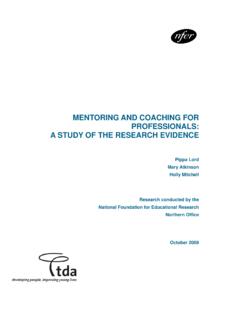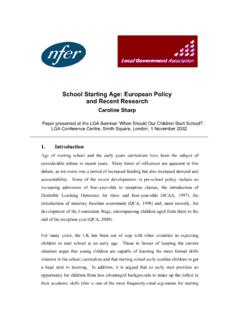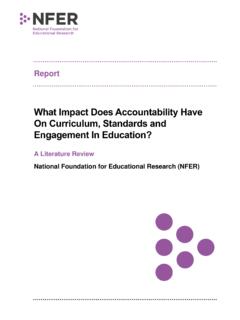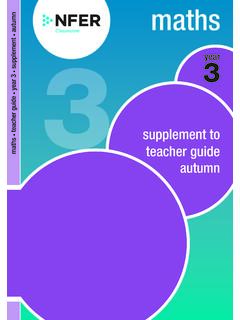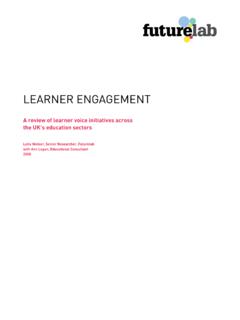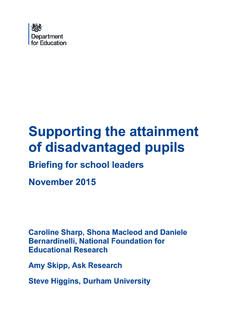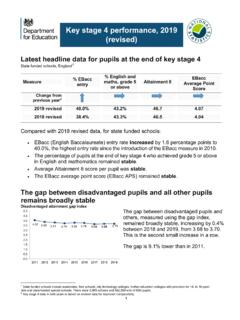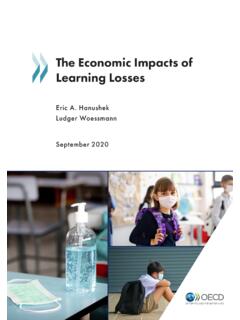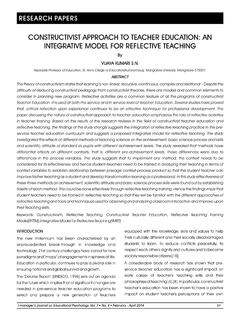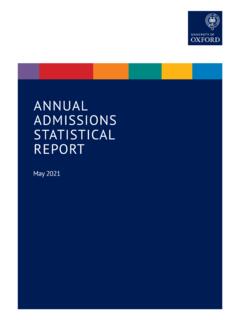Transcription of Schools’ responses to Covid-19: The challenges facing ...
1 Schools responses to covid -19 The challenges facing schools and pupils in September 2020 Caroline Sharp, Julie Nelson, Megan Lucas, Jenna Julius, Tami McCrone and David Sims2 Contents Acknowledgements ..3 Executive summary ..41 Introduction .. Space, movement and cleaning considerations .. Curriculum, and teaching and learning .. Preparing for local lockdown .. This research ..112 Pupils learning during covid -19 and the need for catch up .. Introduction .. To what extent have pupils fallen behind as a result of covid -19? .. Catch-up support .. Conditions which have influenced pupils learning during the summer term ..253 Schools plans for the next acadmic year .. Introduction .. Manageability of opening schools fully from September 2020 .. Will schools have the teachers they need? .. Future learning priorities, catch-up support and plans for using government funding .. Preparing for alternative scenarios ..45 References ..54 Technical appendices ..58 Appendix A: Sample weighting.
2 58 Appendix B: Method used to estimate additional costs associated with covid -19 ..58 Appendix C: Regression models ..59 3 AcknowledgmentsThis report is part of a larger research project focusing on schools responses to covid -19. The NFER team would like to thank everyone who commented on the priority themes for this part of the work. We are particularly grateful to all participating senior leaders and teachers for their time in completing the surveys. We are also thankful to the huge team of NFER staff who contributed to the survey, statistical analysis and report production. Particular thanks are due to Simon Rutt, lead statistician and to Kathryn Hurd and her survey administration NFER team would also like to thank the Nuffield Foundation for co-funding this research with Nuffield Foundation is an independent charitable trust with a mission to advance social well-being. It funds research that informs social policy, primarily in education, welfare, and justice. It also funds student programmes that provide opportunities for young people to develop skills in quantitative and scientific methods.
3 The Nuffield Foundation is the founder and co-funder of the Nuffield Council on Bioethics and the Ada Lovelace Institute. The Foundation has funded this project, but the views expressed are those of the authors and not necessarily the Foundation. Visit The National Foundation for Educational Research (NFER) is an independent, not-for-profit organisation dedicated to producing high-quality, independent research and insights to inform key decision-makers about issues across the education system. Our mission is to generate evidence and insights that can be used to improve outcomes for future generations everywhere, and to support positive change across education systems. Visit 4 Executive summary1 The remaining one per cent of teachers report that girls have fallen further behind normal expectations than covid -19 pandemic continues to impact on all areas of society, including education. On 20 March 2020, schools closed their gates to all pupils apart from vulnerable pupils and children of keyworkers.
4 In June, primary schools opened to selected year groups (Nursery, Reception, Year 1 and Year 6) and secondary schools invited pupils in Years 10 and 12 to have at least some face-to-face contact with their teachers. On 23 June, the Prime Minister confirmed that primary and secondary schools in England would return with full attendance in September (Danechi and Roberts, 2020). The Government (DfE, 2020e) acknowledged the challenge of achieving a balance between the priority of fully opening schools and controlling the spread of the covid -19 virus. Schools are asked to ensure high standards of hygiene (for example through regular hand sanitising, deep cleaning and avoiding pupils sharing equipment). They are also asked to promote social distancing as far as possible (for example by splitting classes into smaller groups and keeping these separate from one other, and by separating year groups, reducing movement around the school , arranging desks in forward- facing rows, asking staff to socially distance and minimising the number of staff working with each group).
5 This research investigates the impact of covid -19 on mainstream primary and secondary schools in England. It follows an earlier NFER survey of schools responses to covid -19 in May (see Nelson and Sharp, 2020) and focuses on the challenges schools will face from September. It considers the extent to which pupils are behind in their curriculum learning in relation to teachers normal expectations for the end of the school year; the impact of covid -19 on the disadvantage gap ; the need for catch-up support from September; and the logistical issues and resource implications of opening schools fully while taking measures to reduce the risk of infection. It also considers schools experiences of offering remote learning from March, and blended learning (remotely and in- school ) from June, in order to inform decisions about the support and resources that schools will need in the event of future lockdowns. FindingsPupils learning during covid -19 and the need for catch up Nearly all teachers (98 per cent) report that their pupils are behind where they would normally expect them to be in their curriculum learning at the end of the 2019/20 school year.
6 Teachers estimate that their pupils are three months behind, on average. The majority (78 per cent) see no difference between girls and boys in this respect, but 21 per cent say that boys have fallen further behind normal expectations than girls1. Teachers report covering, on average, only 66 per cent of the usual curriculum during the 2019/20 school year. Over half (61 per cent) of teachers report that the learning gap between disadvantaged pupils and their peers has widened since the previous year, with the remainder judging that the disadvantaged learning gap had remained the same (32 per cent) or reduced (seven per cent). Based on teacher estimates, on average, the gap between disadvantaged pupils and their peers had increased by 46 per cent. There is a wide range of uncertainty around this estimate, and it is likely to be an underestimate, as differences between schools may have also contributed to changes in the disadvantaged learning gap. Teachers in the most deprived schools are over three times more likely to report that their pupils are four months or more behind in their curriculum-related learning in July, compared to teachers in the least deprived schools (53 per cent compared to 15 per cent).
7 5 Why are pupils falling behind? Importantly, the reasons for pupils falling behind are not entirely due to school closure, schools remote learning offer or pupils engagement with it, but also about limitations on the quality of pedagogy when schools reopened. The negative impact of social distancing requirements on teaching practice is noted below. Failure to address this when schools reopen in September may lead to pupils falling further behind in their learning. The majority of pupils were expected to learn at home throughout the summer term, but pupil engagement in remote learning in July was low, with teachers reporting that only 38 per cent of pupils returned their last piece of set work in June/July. Parental engagement, which is critical to the engagement of pupils - especially those of primary school age, was also comparatively low, at 44 per cent. In the second half of the summer term, schools invited certain year groups to return. However, senior leaders reported only 56 per cent of the pupils eligible to attend actually did2.
8 Attendance was lower among pupils eligible for the pupil Premium (45 per cent) and those from Black, Asian and Minority Ethnic (BAME) backgrounds (49 per cent). Parents safety concerns were keeping children away from school . According to senior leaders, a key reason for non-attendance was parents thinking it was not safe to send their children to school (32 per cent of senior leaders indicated this was a common reason for non-attendance). Leaders in schools with high proportions of pupils from BAME backgrounds were more likely to report parents having safety concerns than schools with no BAME pupils (65 compared to 35 per cent). This may reflect medical evidence suggesting that individuals from BAME backgrounds are at higher risk from covid -19 (PHE, 2020). Parental fines for children s absence are being reintroduced from September. However, consideration needs to be given to the types of families who are most likely to keep their children away from school (low income and BAME families), and whether fines are the most appropriate mechanism to support their children s return to The DfE estimated (2020b) that, among primary schools open to at least one key transition year group, at the end of term, daily attendance rates were at 49 per cent for Year 6 pupils, 40 per cent for Year 1 pupils, and 42 per cent for pupils in Reception.
9 Among secondary schools open to key year groups, the DfE estimated that daily attendance rates for Year 10 and Year 12 were 15 per cent and 14 per cent respectively. The quality of in- school teaching was also impacted by covid -19. Almost three-quarters of teachers (74 per cent) did not feel able to teach to their usual standard under the regulations that were in force in July. In an open- response question, almost half said that distancing requirements had negatively impacted their teaching practices. They were no longer able to utilise core elements of their teaching practices such as group work and practical work, nor did they feel able to move around the classroom to teach, support and interact with their pupils effectively. Similarly, two-fifths of teachers (40 per cent) reported that they no longer had access to their usual resources such as equipment and learning materials. Teachers also highlighted the difficulties caused by pupils not being able to share resources, as they would usually do.
10 Social distancing requirements resulted in over half of senior leaders (51 per cent) reporting that they were using teaching assistants (TAs) to lead classes as a way of managing the supervision of smaller classes, and 46 per cent of teachers said that they were mainly teaching pupils they did not usually teach. Recovering learning from September Teachers estimate that 44 per cent of their pupils are in need of intensive catch-up support (over and above normal expectations for this type of support). Teachers estimates are 25 percentage points higher in the most deprived schools, compared to the least deprived schools. They are also significantly higher (by 18 percentage points) in schools serving the highest proportion of pupils from BAME backgrounds, and this relationship persists after controlling for the effects of deprivation ( the percentage of pupils eligible for free school meals (FSM)). Senior leaders top priorities for September are to provide support for pupils emotional and mental health and well-being (81 per cent); to re-engage pupils with learning (64 per cent); and to settle them into school (63 per cent).
